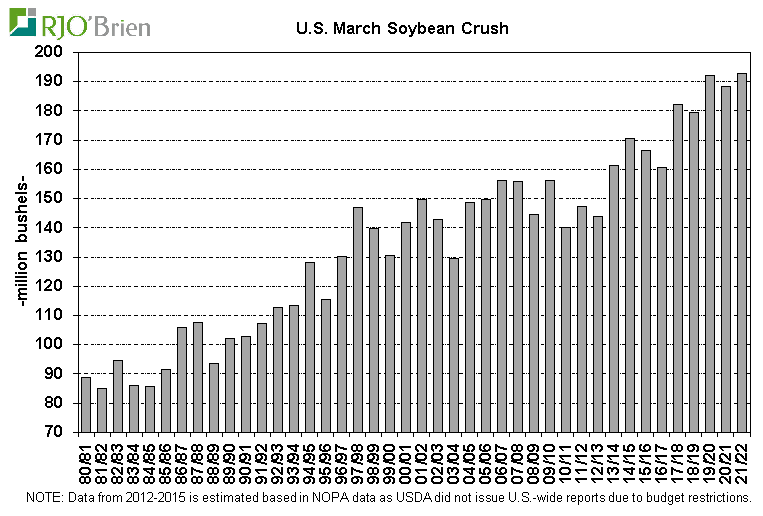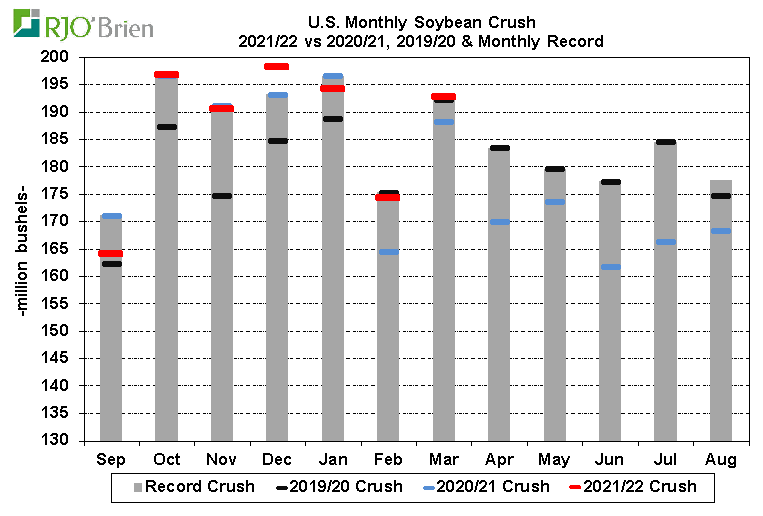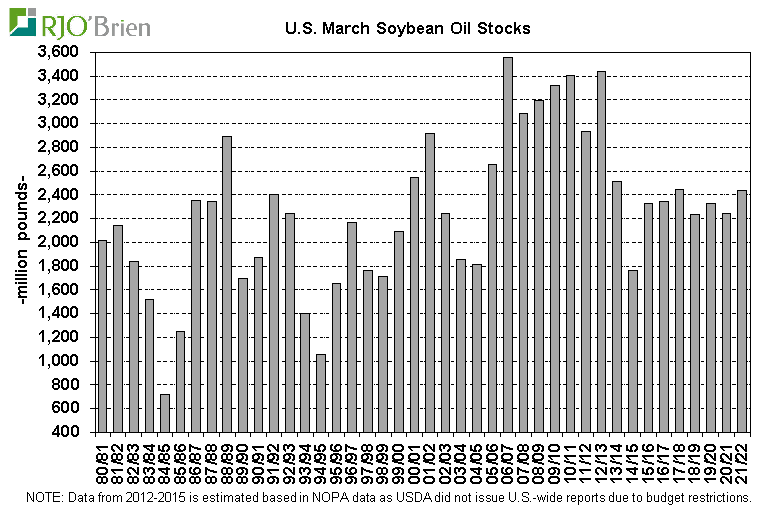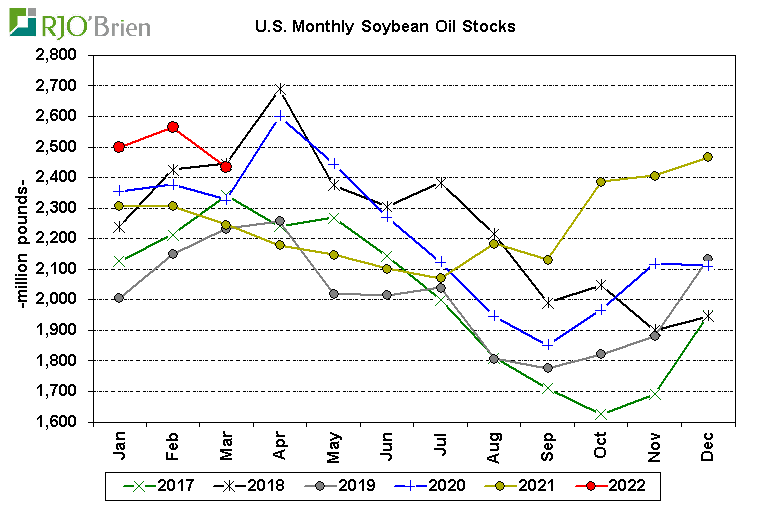-March U.S. soybean crush as expected – record high
-March U.S. soybean oil stocks as expected
USDA reported U.S. soybean crush in March was 192.8 million bushels, exactly in line with average market expectations (191.0-194.5 million range of ideas), 2.5% above last year’s March crush of 188.2 million bushels and a new record for the month in surpassing March 2020’s 192.2 million bushels. The daily average crush rate of 6.22 million bushels/day was nearly identical to February’s 6.23 million/day (monthly crush of 174.4 million bushels) and compared to 6.07 million bushels/day last year March. With official data now through seven months of 2021/22, marketing year-to-date crush of 1.312 billion bushels compares to 1.301 billion last year (1.265 billion in 2019/20), leaving April-August crush needing to total 904 million bushels in order to reach the USDA’s annual target of 2.215 billion bushels vs last year’s tight supply-reduced 840 million bushels, a 7.5% increase, and just above 2019/20’s current record Apr-Aug crush of 899 million bushels. With crush margins remaining extremely strong and biodiesel production, renewable diesel in particular, regularly hitting new monthly records, we have no concern of crush not living up to the USDA’s target at this time.



USDA reported U.S. soybean oil production in March was 2.278 billion pounds vs 2.064 billion in February and 2.222 billion pounds last year March, with the average soybean oil yield of 11.81 pounds/bushel in March holding steady from February’s 11.83 and in line with last year’s March yield also of 11.81 lbs/bu. Nationwide soybean oil production in March was 6.0% larger than production reported by NOPA members only of 2.150 billion pounds, reflecting an increase from the 4.8% difference in February, but in line with the average increase so far in 2021/22 of 6.0%, as well. USDA reported U.S. soybean oil stocks at the end of March were 2.434 billion pounds, right in line with average market expectations of 2.431 billion pounds (2.400-2.488 billion range of ideas) and declining from February stocks of 2.566 billion pounds but still well above year ago March stocks of 2.245 billion pounds. March stocks were the highest for the month in four years and fell just below 2018’s 2.444 billion pounds to be the 2nd highest of the last eight years. Nationwide soybean oil stocks in March were 27.6% larger than NOPA-member stocks, reflecting an increase from the 24.6% difference in February and the largest percentage difference between the two in four months. Last year’s nationwide March soybean oil stocks were 26.8% larger than NOPA stocks and 22.5% larger in March 2020. Based on estimated exports for the month (official March export data will be out Wednesday), soybean oil domestic usage was implied up roughly 1% from last year and followed February’s 5.5% year-over-year increase, putting total implied domestic usage through the first half of 2021/22 at 12.11 billion pounds, up 4.6% from last year’s 11.578 billion pounds. The USDA’s marketing year total domestic usage estimate of 25.085 billion pounds reflects an estimated 7.6% increase from last year. With the slowdown in crush during the 2nd half of last year, and resultant pullback in soybean oil production, stronger year-over-year relative gains in domestic usage from this point forward are to be expected.
U.S. soybean meal production in March was 4.550 million tons vs 4.090 million in February and 4.477 million tons last year March, putting Oct-Mar marketing year-to-date production at 26.85 million tons vs 26.73 million tons last year. Based on estimated exports for the month, March implied soybean meal domestic usage was up less than 1% from last year and followed February’s statistical aberration of a 17% year-over-year, which resulted from the comparison to a historically low figure in February 2021. In the other five months so far in 2021/22, soybean meal domestic usage has averaged 0.7% above year levels. Overall, Oct-Mar implied domestic soybean meal usage of 19.69 million tons is up 2.9% from last year’s 19.13 million, while the USDA’s 2021/22 marketing year total domestic usage estimate of 38.1 million tons reflects an expected 1.4% increase on the year. Again, based on the average year-over-year increases so far this year, besides the February aberration, domestic usage appears to be progressing mostly in line with the USDA’s annual target.


